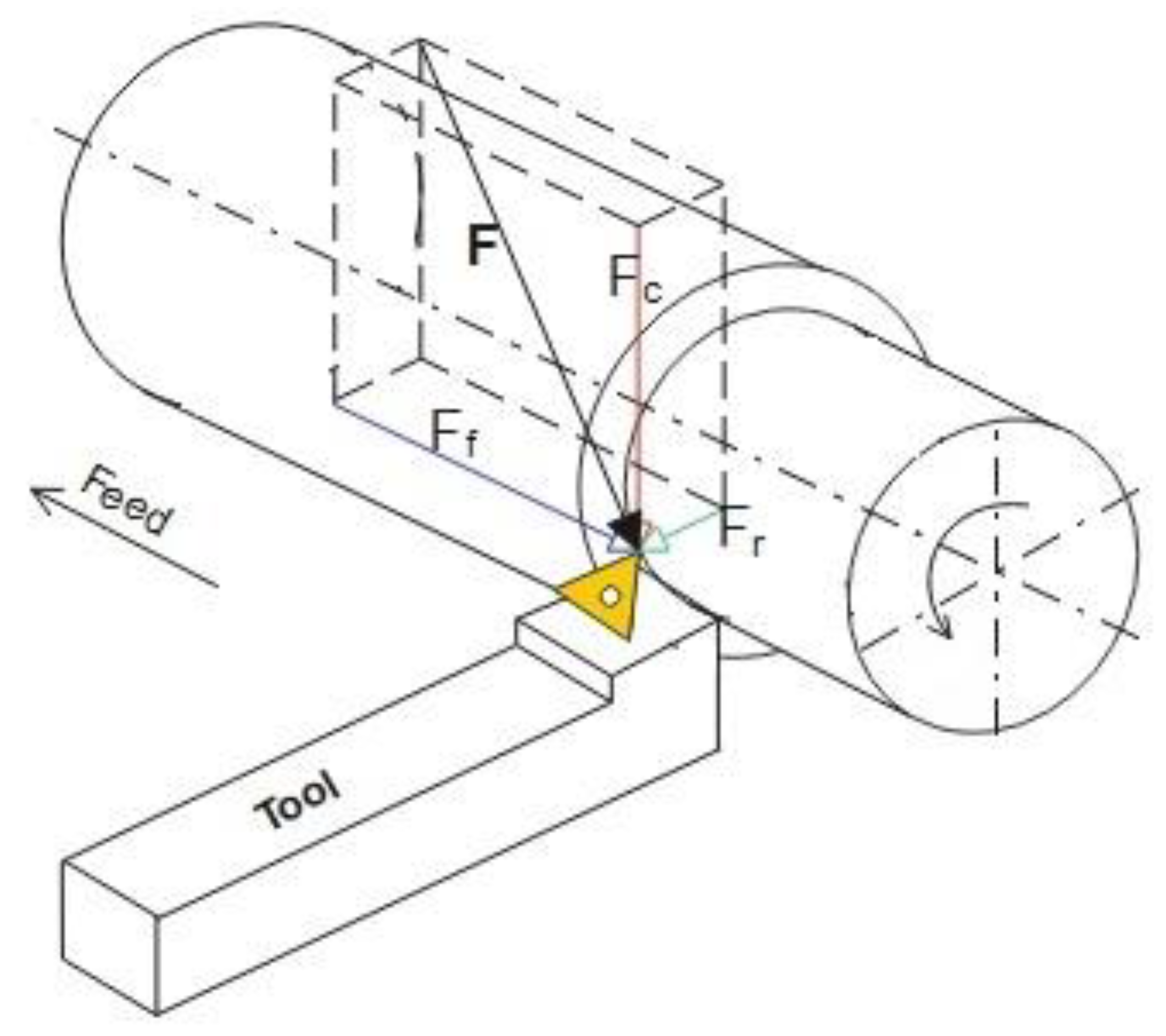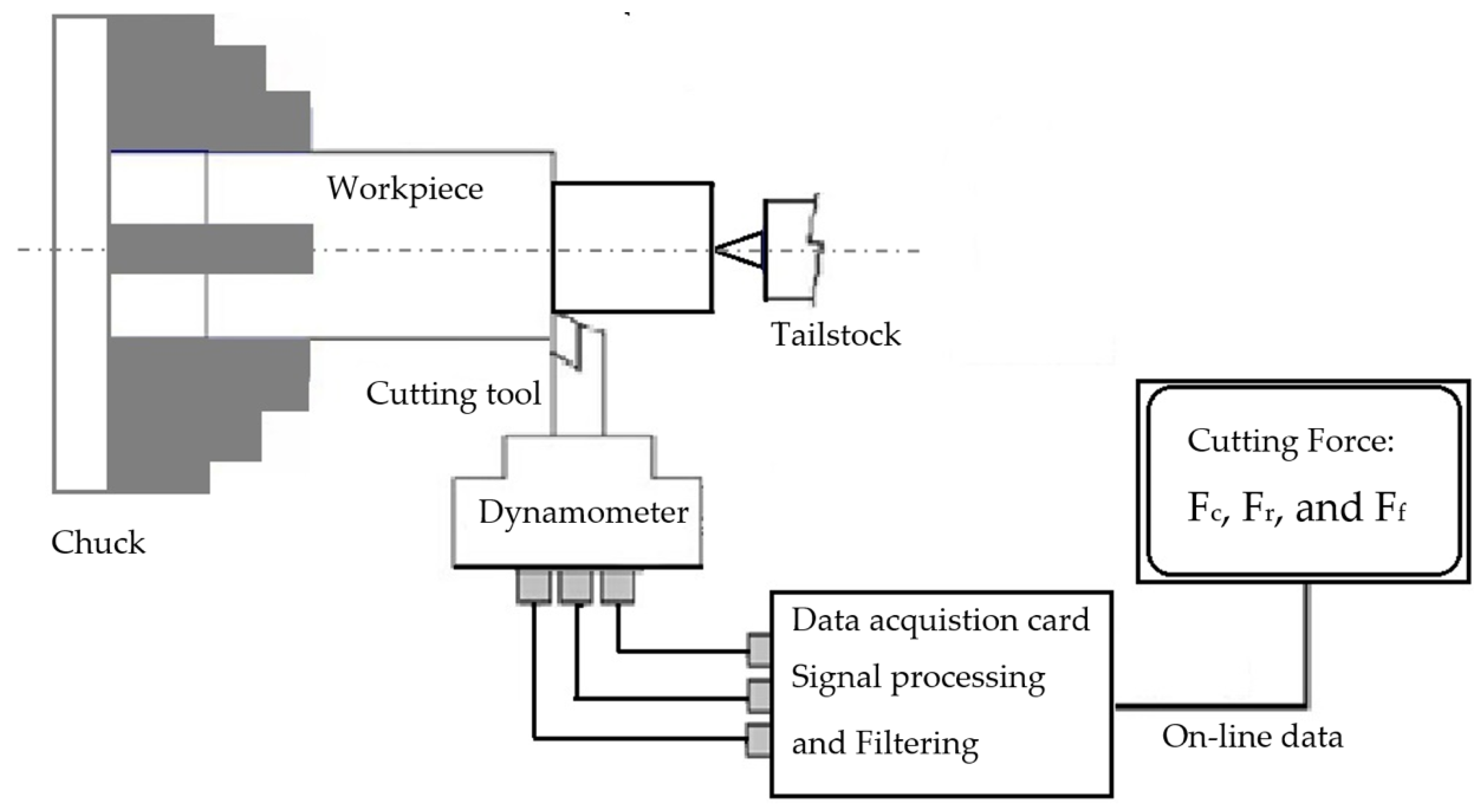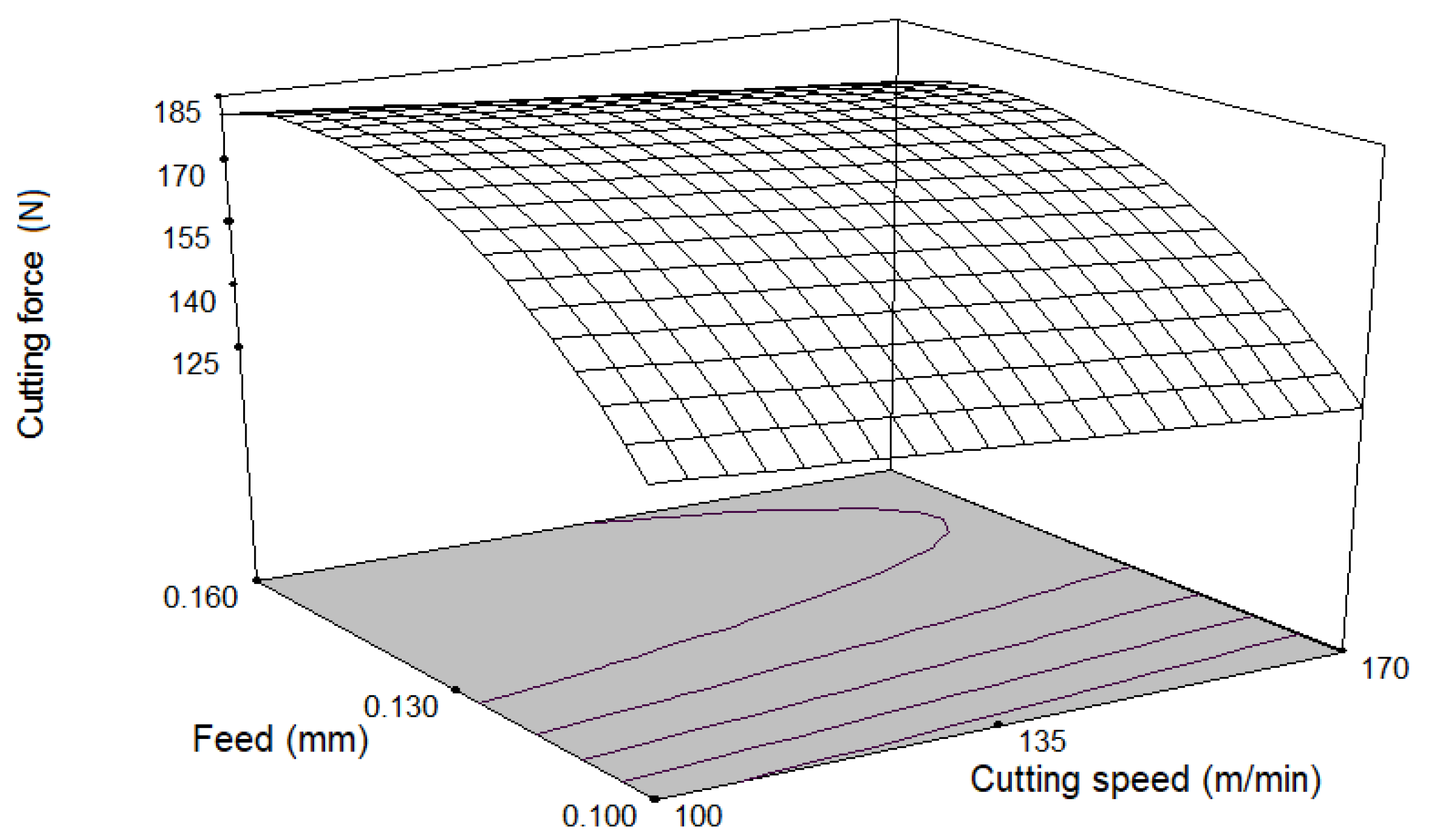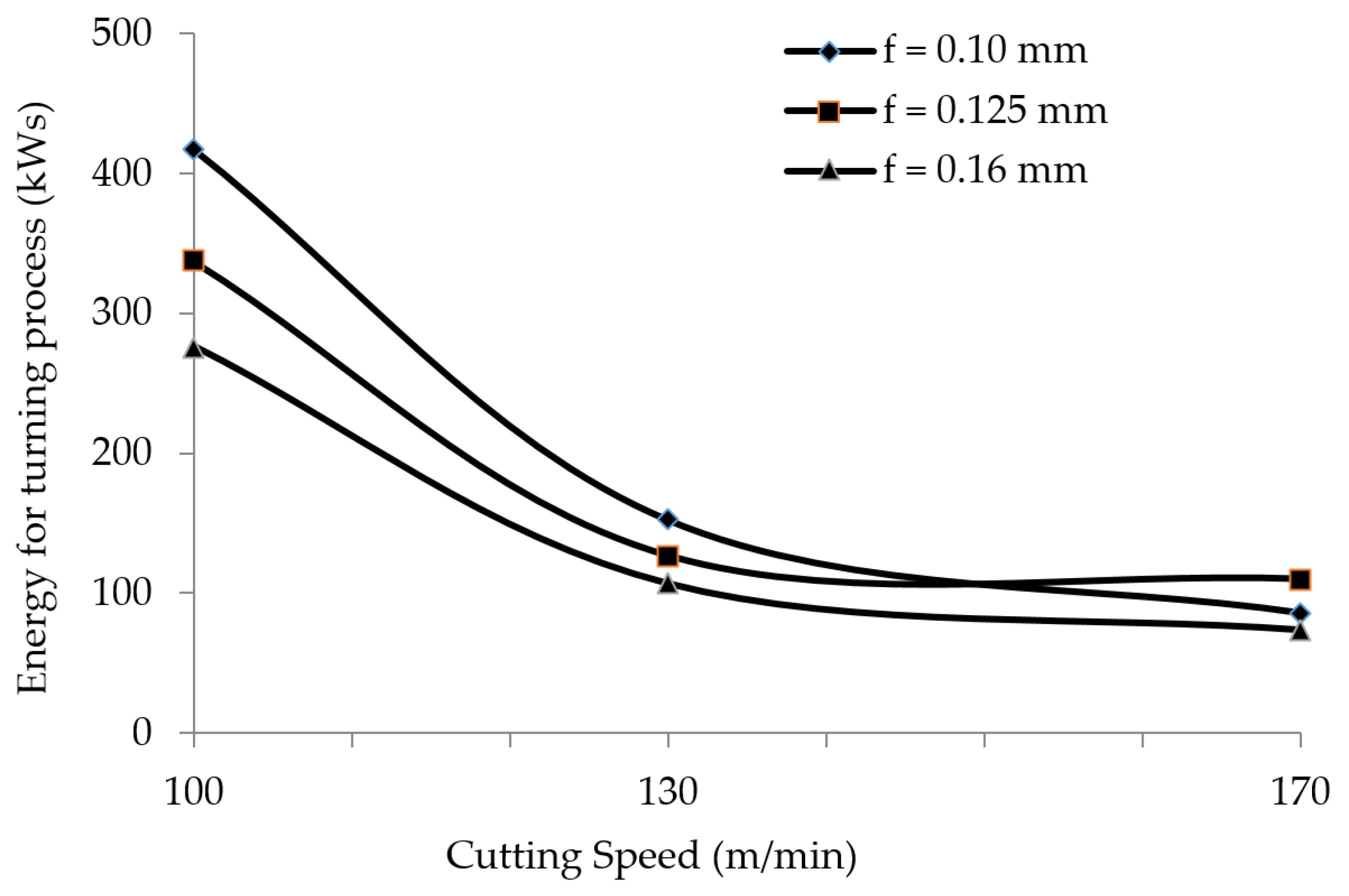Determination of Energy Consumption during Turning of Hardened Stainless Steel Using Resultant Cutting Force
Abstract
1. Introduction
2. Cutting Forces and Energy Consumption Calculation in Finish Turning Process
3. Case Study
3.1. Experimental
3.2. Experimental Design
4. Results and Discussion
4.1. Surface Roughness and Tool Life
4.2. Cutting Force
4.3. Energy Consumption
4.4. Optimum Cutting Parameters for the Case Study
- hard turning as a final operation must produce a smooth surface finish to meet customer demand for the geometric accuracy of machined components
- the machine shop would prefer the cutting tools to last longer
- cutting force should be low to minimize damage on the machined surface, and
- energy consumption should be minimized for each workpiece volume removed.
5. Conclusions
- For the cutting forces, the tangential force was lower than the radial force at some cutting parameters and the feed force is the lowest among the three force components. This is typical for finish turning.
- The cutting speed is inversely proportional to the cutting force while the feed is proportional to the cutting force.
- Machining energy is inversely proportional to the cutting speed and the feed. There was also an effect of the interaction between cutting speed and feed to the machining energy.
- Comparison with another machining energy calculation approach using specific machining energy and material removal rate found the calculated machining energy using resultant cutting force proposed in this study to be similar. When the conventional approach was used where the tangential cutting force was used, the calculated machining energy will be much lower (57–70%) than the proposed approach’s values.
- Through optimization to minimize E2, subject to Ra ≤ 0.65 μm, T ≥ 6 min, and F ≤ 163 N, it was found that for the particular finish hard turning, the optimum cutting parameters were cutting speed is 132.42 m/min and feed is 0.12 mm.
Author Contributions
Funding
Institutional Review Board Statement
Informed Consent Statement
Data Availability Statement
Conflicts of Interest
References
- Jawahir, I.S.; Schoop, J.; Kaynak, Y.; Balaji, A.K.; Ghosh, R.; Lu, T. Progress toward modeling and optimization of sustainable machining processes. J. Manuf. Sci. Eng. 2020, 142, 110811. [Google Scholar] [CrossRef]
- Dahmus, J.B.; Gutowski, T.G. An environmental analysis of machining. ASME Int. Mech. Eng. Congr. Expo. 2004, 47136, 643–652. [Google Scholar]
- Grzesik, W. Advanced Machining Processes of Metallic Materials: Theory, Modelling and Applications; Elsevier: Amsterdam, The Netherlands, 2016. [Google Scholar]
- Munoz, A.A.; Sheng, P. An analytical approach for determining the environmental impact of machining processes. J. Mater. Proc. Technol. 1995, 53, 736–758. [Google Scholar] [CrossRef]
- Choi, A.C.K.; Kaebernick, H.; Lai, W.H. Manufacturing processes modelling for environmental impact assessment. J. Mater. Proc. Technol. 1997, 70, 231–238. [Google Scholar] [CrossRef]
- Kara, S.; Li, W. Unit process energy consumption models for material removal processes. CIRP Ann. Manuf. Technol. 2011, 60, 37–40. [Google Scholar] [CrossRef]
- Hu, S.; Liu, F.; He, Y.; Hu, T. An on-line approach for energy efficiency monitoring of machine tools. J. Clean. Prod. 2012, 27, 133–140. [Google Scholar] [CrossRef]
- He, Y.; Liu, B.; Zhang, X.; Gao, H.; Liu, X. A modeling method of task-oriented energy consumption for machining manufacturing system. J. Clean. Prod. 2012, 23, 167–174. [Google Scholar] [CrossRef]
- Sihag, N.; Sangwan, K.S. A systematic literature review on machine tool energy consumption. J. Clean. Prod. 2020, 275, 123125. [Google Scholar] [CrossRef]
- Vijayaraghavan, A.; Dornfeld, D. Automated energy monitoring of machine tools. CIRP Ann. Manuf. Technol. 2010, 59, 21–24. [Google Scholar] [CrossRef]
- Rajemi, M.F.; Mativenga, P.T.; Aramcharoen, A. Sustainable machining: Selection of optimum turning conditions based on minimum energy considerations. J. Clean. Prod. 2010, 18, 1059–1065. [Google Scholar] [CrossRef]
- Bartarya, G.; Choudhury, S.K. State of the art in hard turning. Int. J. Mach. Tools Manuf. 2012, 53, 1–14. [Google Scholar] [CrossRef]
- Astakhov, V.P.; Xiao, X. A methodology for practical cutting force evaluation based on the energy spent in the cutting system. Mach. Sci. Technol. 2008, 12, 325–347. [Google Scholar] [CrossRef]
- Li, W.; Kara, S. An empirical model for predicting energy consumption of manufacturing processes: A case of turning process. Proc. Inst. Mech. Eng. Part. B J. Eng. Manuf. 2011, 225, 1636–1646. [Google Scholar] [CrossRef]
- Chudy, R.; Grzesik, W.; Zak, K. Influence of machining conditions on the energy consumption and productivity in finish hard turning. In Advances in Manufacturing; Springer: Cham, Switzerland, 2018; pp. 697–705. [Google Scholar]
- Elmunafi, M.H.S.; Noordin, M.Y.; Kurniawan, D. Effect of cutting speed and feed in turning hardened stainless steel using coated carbide cutting tool under minimum quantity lubrication using castor oil. Adv. Mech. Eng. 2015, 7, 1–7. [Google Scholar] [CrossRef]
- Huang, Y.; Liang, S.Y. Cutting forces modeling considering the effect of tool thermal property—application to CBN hard turning. Int. J. Mach. Tool Manuf. 2003, 43, 307–315. [Google Scholar] [CrossRef]
- Grzesik, W.; Denkena, B.; Żak, K.; Grove, T.; Bergmann, B. Energy consumption characterization in precision hard machining using CBN cutting tools. Int. J. Adv. Manuf. Technol. 2016, 85, 2839–2845. [Google Scholar] [CrossRef][Green Version]
- Zorev, N.N. (Ed.) Metal Cutting Mechanics; Pergamon Press: Oxford, UK, 1966. [Google Scholar]
- Nur, R.; Noordin, M.Y.; Izman, S.; Kurniawan, D. Machining parameters effect in dry turning of AISI 316L stainless steel using coated carbide tools. Proc. Inst. Mech. Eng. E J. Process. Mech. Eng. 2017, 231, 676–683. [Google Scholar] [CrossRef]
- Gutowski, T.; Dahmus, J.; Thiriez, A. Electrical energy requirements for manufacturing processes. In Proceedings of the 13th CIRP International Conference on Life Cycle Engineering, Leuven, Belgium, 31 May–2 June 2006; Volume 31, pp. 623–638. [Google Scholar]
- Li, W.; Zein, A.; Kara, S.; Herrmann, C. An investigation into fixed energy consumption of machine tools. In Glocalized Solutions for Sustainability in Manufacturing; Springer: Berlin, Germany, 2011; pp. 268–273. [Google Scholar]
- Mori, M.; Fujishima, M.; Inamasu, Y.; Oda, Y. A study on energy efficiency improvement for machine tools. CIRP Ann. Manuf. Technol. 2011, 60, 145–148. [Google Scholar] [CrossRef]
- Walsh, R.A. Handbook of Machining and Metalworking Calculations; McGraw-Hill Education: New York, NY, USA, 2001. [Google Scholar]
- Noordin, M.Y.; Kurniawan, D.; Tang, Y.C.; Muniswaran, K. Feasibility of mild hard turning of stainless steel using coated carbide tool. Int. J. Adv. Manuf. Technol. 2012, 60, 853–863. [Google Scholar] [CrossRef]
- Ambhore, N.; Kamble, D. Experimental investigation of tool wear and induced vibration in turning high hardness AISI52100 steel using cutting parameters and tool acceleration. Facta Univ. Mech. Eng. 2020, 18, 623–637. [Google Scholar]
- Derringer, G.; Suich, R. Simultaneous optimization of several response variables. J. Qual. Technol. 1980, 12, 214–219. [Google Scholar] [CrossRef]
- Montgomery, D.C. Design and Analysis of Experiments; John Wiley & Sons: Hoboken, NJ, USA, 2012. [Google Scholar]





| Factor | Coded Form | ||
|---|---|---|---|
| −1 | 0 | 1 | |
| x1–cutting speed (m/min) | 100 | 130 | 170 |
| x2–feed (mm) | 0.10 | 0.125 | 0.16 |
| vc (m/min) | f (mm) | Ra (μm) | T (min) |
|---|---|---|---|
| 100 | 0.10 | 0.60 | 30.50 |
| 130 | 0.10 | 0.54 | 8.84 |
| 170 | 0.10 | 0.47 | 3.93 |
| 100 | 0.125 | 0.87 | 19.20 |
| 130 | 0.125 | 0.73 | 5.50 |
| 170 | 0.125 | 0.50 | 3.90 |
| 100 | 0.16 | 0.92 | 15.00 |
| 130 | 0.16 | 0.78 | 4.65 |
| 170 | 0.16 | 0.74 | 2.50 |
| 130 | 0.125 | 0.42 | 5.18 |
| 130 | 0.125 | 0.68 | 7.00 |
| Source | Sum of Squares | Degrees of Freedom | Mean Square | F Value | p Value |
|---|---|---|---|---|---|
| Surface roughness | |||||
| Model | 0.19 | 2 | 0.095 | 8.94 | 0.009 |
| x1 | 0.07 | 1 | 0.07 | 6.8 | 0.031 |
| x2 | 0.12 | 1 | 0.12 | 11.13 | 0.01 |
| Residual | 0.09 | 8 | 0.01 | ||
| Cor Total | 0.28 | 10 | |||
| Tool Life | |||||
| Model | 5.73 | 3 | 1.91 | 104 | <0.001 |
| x1 | 4.92 | 1 | 4.92 | 267.93 | <0.001 |
| x2 | 0.53 | 1 | 0.53 | 28.99 | 0.001 |
| x12 | 0.57 | 1 | 0.57 | 31.27 | 0.008 |
| Residual | 0.13 | 7 | 0.018 | ||
| Cor Total | 5.86 | 10 |
| vc (m/min) | f (mm) | t2 (s) | Fr (N) | Fc (N) | Ff (N) | F (N) | E2 (kWs) | E2# (kWs) |
|---|---|---|---|---|---|---|---|---|
| 100 | 0.10 | 1830 | 103 | 80 | 39 | 136.12 | 417.11 | 428.93 |
| 130 | 0.10 | 530.4 | 100 | 75 | 38 | 130.65 | 152.07 | 162.81 |
| 170 | 0.10 | 235.8 | 96 | 73 | 35 | 125.58 | 85.82 | 95.46 |
| 100 | 0.125 | 1152 | 128 | 110 | 44 | 174.41 | 336.80 | 337.93 |
| 130 | 0.125 | 330 | 125 | 115 | 42 | 174.97 | 127.03 | 127.05 |
| 170 | 0.125 | 234 | 123 | 100 | 41 | 163.74 | 110.48 | 117.95 |
| 100 | 0.16 | 900 | 127 | 124 | 45 | 183.11 | 276.59 | 337.93 |
| 130 | 0.16 | 279 | 118 | 120 | 43 | 173.70 | 106.93 | 137.33 |
| 170 | 0.16 | 150 | 114 | 118 | 41 | 169.12 | 73.80 | 97.13 |
| 130 | 0.125 | 310.8 | 120 | 106 | 40 | 165.03 | 111.13 | 119.77 |
| 130 | 0.125 | 420 | 124 | 113 | 43 | 173.19 | 112.84 | 161.18 |
| Source | Sum of Square | Degrees of Freedom | Mean Square | F Value | p Value |
|---|---|---|---|---|---|
| Model | 3988.78 | 3 | 1329.59 | 134.33 | <0.001 |
| x1 | 205.99 | 1 | 205.99 | 20.81 | 0.003 |
| x2 | 594.82 | 1 | 594.82 | 60.10 | <0.001 |
| x22 | 1154.27 | 1 | 1154.27 | 116.62 | <0.001 |
| Residual | 69.29 | 7 | 9.90 | ||
| Cor Total | 4058.06 | 10 |
| Source | Sum of Square | Degrees of Freedom | Mean Square | F Value | p Value |
|---|---|---|---|---|---|
| Model | 130,900.00 | 4 | 32,715.34 | 98.39 | <0.001 |
| x1 | 93,449.15 | 1 | 93,449.15 | 281.05 | <0.001 |
| x2 | 5854.92 | 1 | 5854.92 | 17.61 | 0.006 |
| x12 | 35,360.36 | 1 | 35,360.36 | 106.35 | <0.001 |
| x1·x2 | 3578.67 | 1 | 3578.67 | 10.76 | 0.017 |
| Residual | 1994.99 | 6 | 332.50 | ||
| Cor Total | 132,900.00 | 10 |
Publisher’s Note: MDPI stays neutral with regard to jurisdictional claims in published maps and institutional affiliations. |
© 2021 by the authors. Licensee MDPI, Basel, Switzerland. This article is an open access article distributed under the terms and conditions of the Creative Commons Attribution (CC BY) license (https://creativecommons.org/licenses/by/4.0/).
Share and Cite
Nur, R.; Yusof, N.M.; Sudin, I.; Nor, F.M.; Kurniawan, D. Determination of Energy Consumption during Turning of Hardened Stainless Steel Using Resultant Cutting Force. Metals 2021, 11, 565. https://doi.org/10.3390/met11040565
Nur R, Yusof NM, Sudin I, Nor FM, Kurniawan D. Determination of Energy Consumption during Turning of Hardened Stainless Steel Using Resultant Cutting Force. Metals. 2021; 11(4):565. https://doi.org/10.3390/met11040565
Chicago/Turabian StyleNur, Rusdi, Noordin Mohd Yusof, Izman Sudin, Fethma M. Nor, and Denni Kurniawan. 2021. "Determination of Energy Consumption during Turning of Hardened Stainless Steel Using Resultant Cutting Force" Metals 11, no. 4: 565. https://doi.org/10.3390/met11040565
APA StyleNur, R., Yusof, N. M., Sudin, I., Nor, F. M., & Kurniawan, D. (2021). Determination of Energy Consumption during Turning of Hardened Stainless Steel Using Resultant Cutting Force. Metals, 11(4), 565. https://doi.org/10.3390/met11040565







